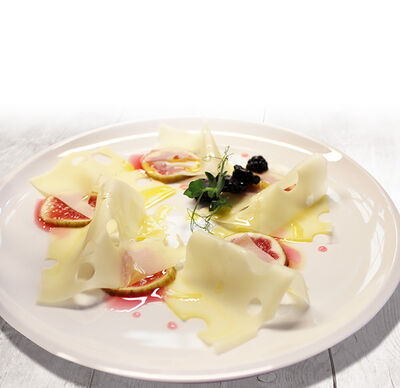Up
- Cheese specialities
Discover Bavaria’s fine cheese - Cheese treats
Recipes, promotions and news- Promotions & news
- Health & region
- A passion for cheese
- Recipes & inspiration
- Roast chicken with bread and Almdammer stuffing
- Fried asparagus with GOLDSTEIG Wafer-Thin Almdammer Cheese Slices with bacon and peaches
- Baked mushrooms stuffed with minced meat topped with Almdammer
- Tiramisu with mango jelly
- Ofenschlupfer with ricotta and mascarpone
- Bacon bomb with Emmental centre
- Halloween finger in hot dog with Emmental and garlic eyes
- Marzipan, mascarpone and ricotta cream with berry ragout
- Bambini Mini Mozzarella salad with lime dressing and oregano
- Dips made from parsley butter and cashew cream
- Tomato and parsley root soup with ricotta
- Pull-apart bread stuffed with garlic paste, Almdammer and Emmental
- Ricotta Obatzter with radishes and chives
- Braised goose breast with oven-baked pretzels and Emmental
- Green salad with mozzarella marinated in passion fruit dressing
- Tomato salad with cashew and ricotta marinade and Bambini Mini Mozzarella
- Braised leg of lamb with polenta ricotta pie
- GOLDSTEIG cheese board
- Tiramisu heart with berry jelly
- Melt in the middle chocolate cake with mascarpone and dark beer
- Cocktail with Bambini Mini Mozzarella, cherry tomatoes stick and tomato sauce
- Spicy Bambini Mini Mozzarella in a cocktail glass
- Bambini Mini Mozzarella salad with vegetable pesto
- Puff pastry snail with cheese stuffing and cheese grissinis
- Millet cheese burger with mustard and honey cream
- 4 variations on Bambini Mini Mozzarella with matching dips
- Chicken leg on Limburger vegetables and sage
- Pork tenderloin turrets with aubergines and tomatoes, garnished with mozzarella slices
- Oven baked pork steak in bread sauce with rich Limburger topping
- Cordon bleu trout with Almdammer and tomato compote
- Vegetable terrine with mozzarella centre
- Ricotta soufflé with fennel
- Mascarpone cream smoothie with orange jelly and cocoa espuma
- Emmental and mozzarella scrambled eggs with cherry tomatoes and parsley
- Cheese on toast with wafer-thin Almdammer and Emmental and ham
- Mozzarella larded with smoked ham
- Spicy lollies: Bambini Mini Mozzarella with cheese balls, peanut flips and caper berries
- Eggs in a glass with Bambini Mini Mozzarella and chives
- Bambini Mini Mozzarella with strawberries and honey
- Bambini Mini Mozzarella with strawberries on chocolate sticks
- Mushrooms stuffed with Almdammer and Bambini Mini Mozzarella
- Pepper, carrot and courgette salad with Bambini Mini Mozzarella
- Classic cheeseburger with Emmental
- Pork belly stuffed with tramezzini and Emmental
- Plaice with mozzarella slices
- Pear, mascarpone and ricotta cream
- Chocolate lollies with Bambini Mini Mozzarella and Amarettinis
- Turkey Picatta with mascarpone and tomato pasta
- Oven-baked spare ribs with grated mozzarella on jacket potatoes and ricotta cream
- Meat loaf stuffed with Bambini Mini Mozzarella
- Stewed creamed potatoes oven baked with wafer-thin Almdammer
- Sushi with Bambini Mini Mozzarella
- Power sandwich with Protinella, fried egg and turkey
- Protinella fitness omelette with tomatoes
- Carrot and courgette pasta with Protinella
- Summer salad with Protinella on vegetables, fruits and orange dressing
- Protinella mini tiramisu cakes
- Carrot and courgette pasta with Protinella
- Carrot and courgette pasta with Protinella
- Carrot and courgette pasta with Protinella
- Carrot and courgette pasta with Protinella
- Carrot and courgette pasta with Protinella
- Our dairy
Natural. Modern. Bavarian. - Farmers
- Trade
- Foodservice
- Contact
- FAQ
- Search










